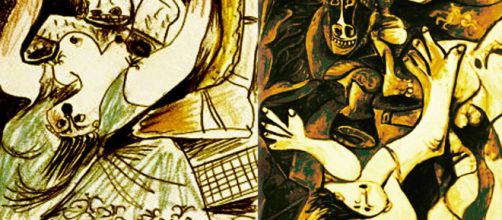Drawing. Remember that old-timey art form? In centuries past, using lines to tell a story was often the preliminary step toward the higher valued form of artistic expression - painting. But if a sketch is good, really good, it can be an end in itself.
Drawing the line
A reminder of the value of drawing can be seen in a show titled “Lines of Beauty” from the Chatsworth Museum collection. The exhibit boasts some 60 Old Master drawings, and all the biggies are represented like Raphael, Rembrandt, and Leonardo. But when it comes to a preparatory sketch for a painting that stands on its own, I’d pick 17th-century artist Nicolas Poussin’s illustration for his painting "The Rape of the Sabines."
Poussin painted two works on the same theme; one hangs at the Met and the other at the Louvre.
But while both are powerful pictures (how could they not be given that they picture abduction and abuse), the preparatory drawing in the Chatsworth collection is the killer image.
By contrast, the figures in the painting look too choreographed, as if in a beautiful ballet. The drawing, far from a pretty picture, captures the ugliness of the attack - the violence of it, the commotion.
Familiar scene
Many artists in the past have been moved to paint the scene described in early Roman history. In 800 BC when Old Rome found itself with more males than females. In a pretense to gain more women, Romulus, the city’s first king, invited the neighboring tribe of the Sabines to a party. When the Sabines arrived with their families, the women were grabbed – wives and daughters alike.
Poussin, clearly touched by the tale, painted it twice. And to emphasize the particular seizing of women of child-bearing age, he painted infants falling out of their mothers’ arms along with the despair of their faces, and the callow air of the armed Romans.
But as horrible as this scene is in the painting, it’s too composed, too orchestrated, and too gorgeously colored to convey the tumult of the attack, the agitation. In contrast, Poussin’s draw nails it. It looks so stirred up, so seething, and so graphic that it conjures up the very raw anti-war pandemonium in Picasso Guernica, which wasn’t painted until two centuries later.
Mark of distinction
And get this. Poussin brought his pen to paper to render this horror not once, but six times.
He gives you a lot to see no matter which drawing you look at. Drama not only comes from the aggressiveness of all the interlock arms and legs of women and soldiers but also from the contrast between the horror and the stately temple-like structures in the background. Between the buildings and the bodies, one emphasizes the other to increases the tension.
And all of this is achieved with a few strokes of a pen with brown ink and a little bit of a wash for shading. Unlike the paintings, chaos in these drawings is made real. The art of drawing doesn’t get the respect it deserves.


